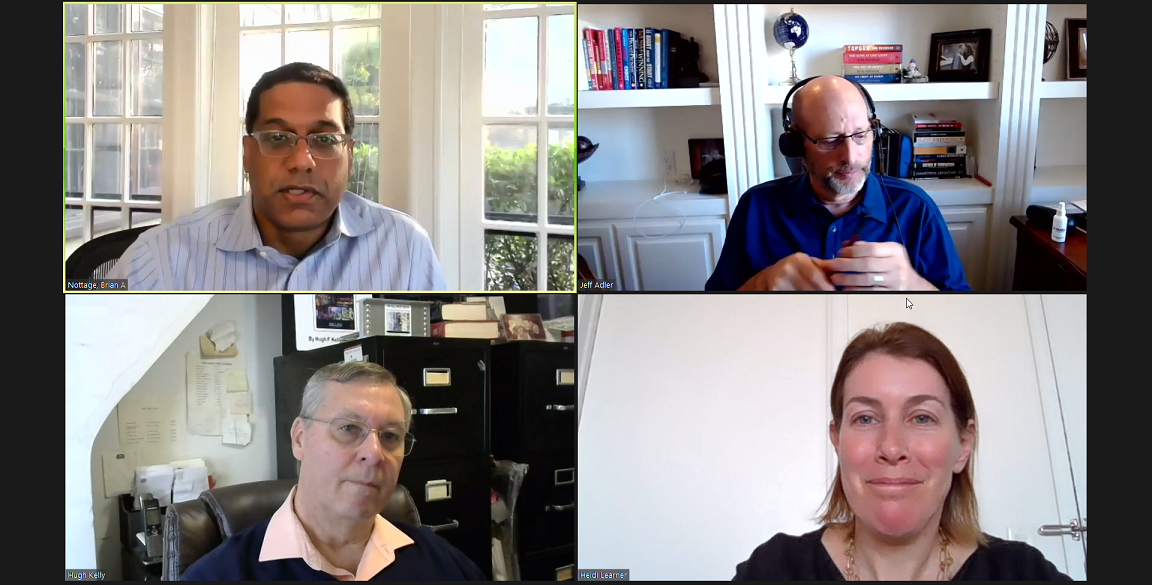CRE and Where the Economy is Heading
Top real estate economists at the CPE-MHN Summit share insights into what's next for the industry.

Clockwise from top left: Brian Nottage, JP Morgan Asset Management; Jeff Adler, Yardi Matrix; Heidi Learner; CBRE Global Investment; Hugh Kelly, Fordham Real Estate Institute
In the home stretch of a tumultuous year, three top real estate economists took the occasion of the CPE-MHN Summit to share their perspectives on recovery, the job market and what’s ahead for office space.
During a spirited discussion moderated by Jeff Adler, vice president & industry principal at Yardi Matrix, what emerged was a complex picture with reasons for both cautious optimism and serious concern.
Once the employment situation stabilizes—most likely by mid-2023—“You will see more consumer spending and travel rebound,” predicted Heidi Learner, Americas head of real estate research at CBRE Global Investors. That, in turn, will give a much-needed boost to the retail and hospitality sectors. Meanwhile, the firm continues to find considerable appeal in multifamily and industrial assets. Despite some concerns about overinvestment in those categories, she added, “We still see the fundamental demand drivers being there.”
“If you look at pricing, you’re not seeing much of a retrenchment, depending on what sector you’re in,” said Brian Nottage, executive director in the real estate group at JP Morgan Asset Management. “The places where prices have fallen are prices where people don’t want to be.”
Timing the Recovery
The potential timing of the recovery brought out varying views. Hugh Kelly, curriculum chair at the Fordham Real Estate Institute and a CPE economics columnist, pointed to longer-term historical trends as guides for the future, rather than economic performance of the past few several quarters.
“Real estate needs to be playing defense. It needs to be hunkered down for a long time,” warned Kelly. “In terms of the people I advise, the dynamic should be, ‘Don’t lose more money.’”
His perspective stems from patterns that developed during the 2010-2019 expansion. Based on an analysis of the range of quarterly GDP growth during that period, Kelly estimates that the next quarterly peak will occur in 2022 at the earliest.
An assessment of employment during the past decade suggests that job growth would peak no earlier than September 2024 and as late as October 2026. Unless the federal government provides a new stimulus package on the order of $2 trillion by February 2021, the economy is likely to experience a double-dip recession comparable to that of 1981-82. Kelly’s fellow panelists concurred in the need for additional government action.
In the meantime, Nottage suggested that the recovery of commercial real estate could continue. “You don’t need the whole economy to come back,” he said.
On the Job

Image by Photo Mix via Pixabay
The panelists challenged the idea that this year’s dramatic expansion of remote work will diminish the need for office space. Some estimates have suggested that allowing one day of remote work per week would reduce demand for office space by 20 percent, but the panelists countered that such assumptions underestimate the value of the office environment.
Rather than undermining the need for office space, variations in employee work schedules underscore it. “You need to have a day when everybody’s in the office,” Nottage contended. “You can’t lop it off because people are working home one day a week.” Despite the high productivity demonstrated by those working remotely, many employers are still skeptical that workers are as productive outside an office setting.
For his part, Kelly called the possibility of a massive decline in demand for office space “highly improbable,” citing surveys indicating that 70 percent of those working remotely want to return to a more normal environment.
Adler speculated that a typical weekly schedule would consist of three days in the office and two days at home. “The team has to meet,” he said, adding that it would be the responsibility of managers to ensure the intentionality of time on the job.
Fostering Change
One overlooked factor in the value of office space is its central role in the development of younger workers. The opportunity to receive in-person mentoring and training offers the significant long-term value of the office setting, Learner said: “The need to collaborate with your younger employees will be the fundamental reason people return to the office.”
What’s ahead for workers who have lost their jobs this year brought divergent views. Adler asked the panel how easy it would be for those out of work to fill jobs in sectors experiencing labor shortages. Learner cited the unlikelihood that a laid-off restaurant or retail worker could quickly change gears and make the transition to some high-demand areas, particularly knowledge work.
Nottage suggested that the development of a vaccine would go a long way toward addressing the employment issue in those industries by making it safe for stores and restaurants to open and for their employees to resume their jobs. “What you need is a system that pays workers and pays restaurants (that) have to close,” he said.
One impact of the pandemic that has long-term implications for commercial real estate is a surge in investment in life science. Nottage predicted that the race to find treatment and develop a vaccine for COVID-19 will generate extensive benefits. Kelly observed that advances are made by creative destruction, and, he added, “We’re seeing the destructive part.” Behind the success of the economy is what Kelly called “our genius for creativity.” Yet he noted that investment in research as a proportion of GDP is less than half of what it was in the 1960s.







You must be logged in to post a comment.